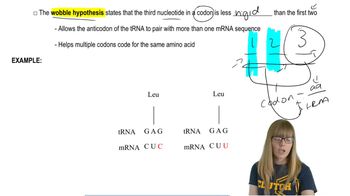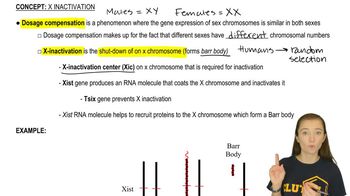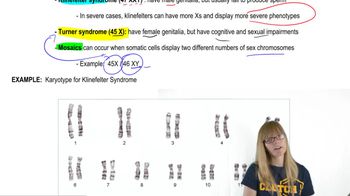Table of contents
- 1. Introduction to Genetics51m
- 2. Mendel's Laws of Inheritance3h 37m
- 3. Extensions to Mendelian Inheritance2h 41m
- 4. Genetic Mapping and Linkage2h 28m
- 5. Genetics of Bacteria and Viruses1h 21m
- 6. Chromosomal Variation1h 48m
- 7. DNA and Chromosome Structure56m
- 8. DNA Replication1h 10m
- 9. Mitosis and Meiosis1h 34m
- 10. Transcription1h 0m
- 11. Translation58m
- 12. Gene Regulation in Prokaryotes1h 19m
- 13. Gene Regulation in Eukaryotes44m
- 14. Genetic Control of Development44m
- 15. Genomes and Genomics1h 50m
- 16. Transposable Elements47m
- 17. Mutation, Repair, and Recombination1h 6m
- 18. Molecular Genetic Tools19m
- 19. Cancer Genetics29m
- 20. Quantitative Genetics1h 26m
- 21. Population Genetics50m
- 22. Evolutionary Genetics29m
3. Extensions to Mendelian Inheritance
Sex Chromosome
Problem 19
Textbook Question
Predict the potential effect of the Lyon hypothesis on the retina of a human female heterozygous for the X-linked red-green color blindness trait.
 Verified step by step guidance
Verified step by step guidance1
Understand the Lyon hypothesis, which states that in females, one of the two X chromosomes is randomly inactivated in each cell, leading to a mosaic pattern of expression for X-linked genes.
Recognize that red-green color blindness is an X-linked recessive trait, meaning that the gene responsible for this condition is located on the X chromosome.
Consider that a heterozygous female has one normal allele and one allele for color blindness on her X chromosomes.
Since X-inactivation is random, some cells in the retina will express the normal allele, while others will express the color blindness allele.
Predict that the retina will have a mosaic pattern, with some areas having normal color vision and others having impaired color vision, potentially leading to partial color blindness.
 Verified video answer for a similar problem:
Verified video answer for a similar problem:This video solution was recommended by our tutors as helpful for the problem above
Video duration:
3mPlay a video:
Was this helpful?
Key Concepts
Here are the essential concepts you must grasp in order to answer the question correctly.
Lyon Hypothesis
The Lyon hypothesis, also known as X-inactivation, states that in female mammals, one of the two X chromosomes is randomly inactivated during early embryonic development. This process ensures dosage compensation between males (XY) and females (XX) for X-linked genes. The inactivated X chromosome forms a Barr body and is largely transcriptionally silent, which can influence the expression of X-linked traits.
Recommended video:
Guided course

Translation:Wobble Hypothesis
X-linked Inheritance
X-linked inheritance refers to the pattern of inheritance for genes located on the X chromosome. In females, who have two X chromosomes, the expression of X-linked traits can be influenced by which X chromosome is inactivated. In the case of X-linked red-green color blindness, a female heterozygous for the trait may express normal vision if the normal allele is on the active X chromosome, while the color blindness allele is on the inactive one.
Recommended video:
Guided course

X-Inactivation
Retinal Function and Color Vision
The retina contains photoreceptor cells, including cones that are responsible for color vision. In humans, the red-green color blindness trait affects the function of specific cone cells, leading to difficulties in distinguishing between red and green hues. In a heterozygous female, the random inactivation of one X chromosome can result in a mosaic pattern of retinal cells, where some cells express normal color vision while others do not, potentially leading to partial color blindness.
Recommended video:
Guided course

Functional Genomics

 4:24m
4:24mWatch next
Master Sex Determination with a bite sized video explanation from Kylia Goodner
Start learningRelated Videos
Related Practice



